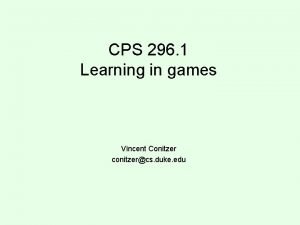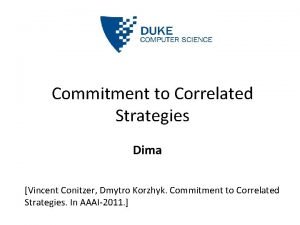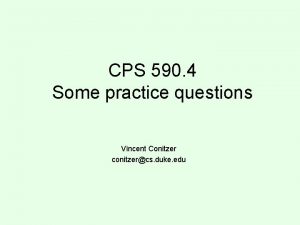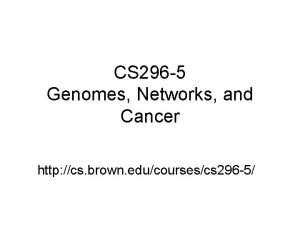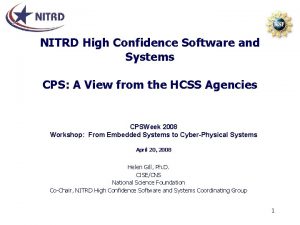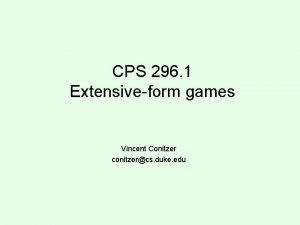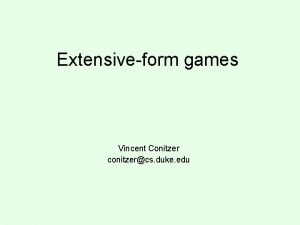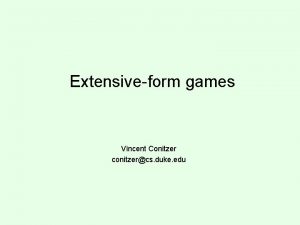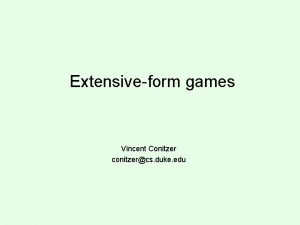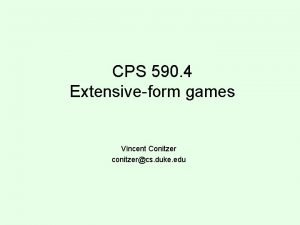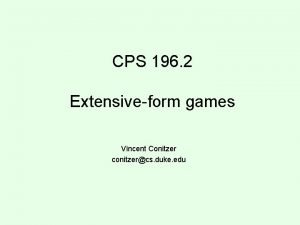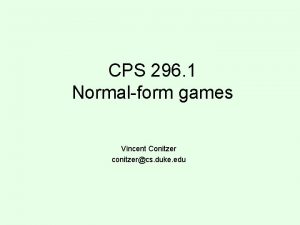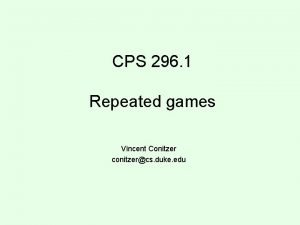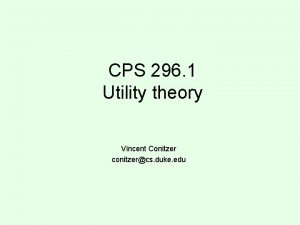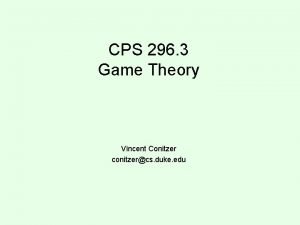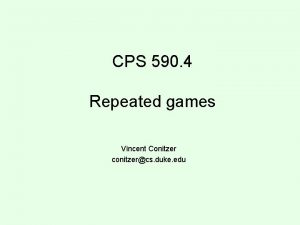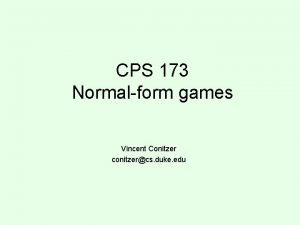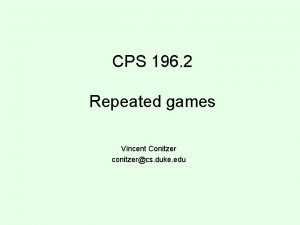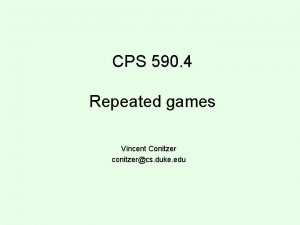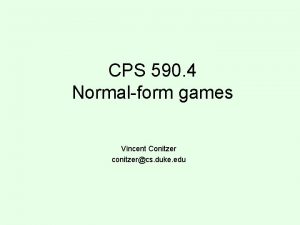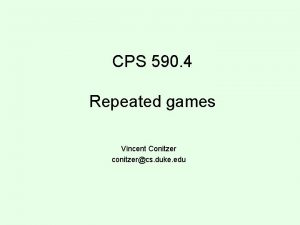CPS 296 1 Extensiveform games Vincent Conitzer conitzercs

















- Slides: 17

CPS 296. 1 Extensive-form games Vincent Conitzer conitzer@cs. duke. edu

Extensive-form games with perfect information Player 1 Player 2 2, 4 Player 2 5, 3 Leaves of the tree show player 1’s utility first, then player 2’s utility 3, 2 1, 0 • Players do not move simultaneously • When moving, each player is aware of all the previous moves (perfect information) • A (pure) strategy for player i is a mapping from player i’s nodes to Player 1 actions 0, 1

Backward induction Player 1 Player 2 • When we know what will happen at each of a node’s children, we can decide the best action for the player who is moving at that node Player 1 2, 4 5, 3 3, 2 1, 0 0, 1

A limitation of backward induction • If there are ties, then how they are broken affects what happens higher up in the tree • Multiple equilibria… Player 1 . 12345 . 87655 Player 2 1/2 3, 2 2, 3 4, 1 1/2 0, 1

Conversion from extensive to normal form Player 1 LR = Left if 1 moves Left, Right if 1 moves Right; etc. LL Player 2 L R 3, 2 2, 3 4, 1 0, 1 LR RL RR 3, 2 2, 3 4, 1 0, 1 • Nash equilibria of this normal-form game include (R, LL), (R, RL), (L, RR) + infinitely many mixed-strategy equilibria • In general, normal form can have exponentially many strategies

Converting the first game to normal form LL Player 1 Player 2 RR 2, 4 5, 3 LR 2, 4 5, 3 RL 3, 2 1, 0 RR 3, 2 0, 1 Player 1 5, 3 RL LL 2, 4 Player 2 2, 4 LR 3, 2 1, 0 0, 1 • Pure-strategy Nash equilibria of this game are (LL, LR), (LR, LR), (RL, LL), (RR, LL) • But the only backward induction solution is (RL, LL)

Subgame perfect equilibrium • Each node in a (perfect-information) game tree, together with the remainder of the game after that node is reached, is called a subgame • A strategy profile is a subgame perfect equilibrium if it is an equilibrium LL LR RL RR for every subgame LL 2, 4 5, 3 Player 1 Player 2 LR 2, 4 5, 3 RL 3, 2 1, 0 RR 3, 2 0, 1 Player 2 *L *R *L 3, 2 1, 0 *R 3, 2 0, 1 2, 4 5, 3 ** *L 1, 0 *R 0, 1 Player 1 3, 2 1, 0 • (RR, LL) and (LR, LR) are not subgame perfect equilibria because (*R, **) is not an equilibrium • (LL, LR) is not subgame perfect because (*L, *R) is not an equilibrium 0, 1 • *R is not a credible threat

Imperfect information • Dotted lines indicate that a player cannot distinguish between two (or more) states – A set of states that are connected by dotted lines is called an information set • Reflected in the normal-form representation Player 1 Player 2 0, 0 Player 2 -1, 1 1, -1 L R L 0, 0 -1, 1 R 1, -1 -5, -5 • Any normal-form game can be transformed into an imperfect-information extensive-form game this way

A poker-like game “nature” 1 gets King player 1 raise check player 2 call fold 2 1 2/3 cc 1/3 rr cf 1/3 fc ff 0, 0 1, -1 2/3 rc . 5, -. 5 1. 5, -1. 5 0, 0 1, -1 cr -. 5, . 5 1, -1 cc 0, 0 1, -1 1 gets Jack call 1 fold call fold 1 1 1 -2 -1

Subgame perfection and imperfect information • How should we extend the notion of subgame perfection to games of imperfect information? Player 1 Player 2 1, -1 Player 2 -1, 1 1, -1 • We cannot expect Player 2 to play Right after Player 1 plays Left, and Left after Player 1 plays Right, because of the information set • Let us say that a subtree is a subgame only if there are no information sets that connect the subtree to parts outside the subtree

Subgame perfection and imperfect information… Player 1 Player 2 4, 1 Player 2 0, 0 5, 1 1, 0 Player 2 3, 2 2, 3 • One of the Nash equilibria is: (R, RR) • Also subgame perfect (the only subgames are the whole game, and the subgame after Player 1 moves Right) • But it is not reasonable to believe that Player 2 will move Right after Player 1 moves Left/Middle (not a credible threat) • There exist more sophisticated refinements of Nash equilibrium that rule out such behavior

Computing equilibria in the extensive form • Can just use normal-form representation – Misses issues of subgame perfection, etc. • Another problem: there are exponentially many pure strategies, so normal form is exponentially larger – Even given polynomial-time algorithms for normal form, time would still be exponential in the size of the extensive form • There are other techniques that reason directly over the extensive form and scale much better – E. g. , using the sequence form of the game

Commitment • Consider the following (normal-form) game: 2, 1 4, 0 1, 0 3, 1 • How should this game be played? • Now suppose the game is played as follows: – Player 1 commits to playing one of the rows, – Player 2 observes the commitment and then chooses a column • What is the optimal strategy for player 1? • What if 1 can commit to a mixed strategy?

Commitment as an extensive -form game • For the case of committing to a pure strategy: Player 1 Up Down Player 2 Left 2, 1 Player 2 Right 4, 0 Left 1, 0 Right 3, 1

Commitment as an extensive -form game • For the case of committing to a mixed strategy: Player 1 (1, 0) (=Up) (0, 1) (=Down) (. 5, . 5) … … Player 2 Left 2, 1 Right 4, 0 Left 1. 5, . 5 Right Left 3. 5, . 5 1, 0 Right • Infinite-size game; computationally impractical to reason with the extensive form here 3, 1

Solving for the optimal mixed strategy to commit to [Conitzer & Sandholm 2006, von Stengel & Zamir 2010] • For every column t separately, we will solve separately for the best mixed row strategy (defined by ps) that induces player 2 to play t • maximize Σs ps u 1(s, t) • subject to for any t’, Σs ps u 2(s, t) ≥ Σs ps u 2(s, t’) Σs p s = 1 • (May be infeasible, e. g. , if t is strictly dominated) • Pick the t that is best for player 1

Visualization L C R U 0, 1 1, 0 0, 0 M 4, 0 0, 1 0, 0 D 0, 0 1, 1 (0, 1, 0) = M C L (1, 0, 0) = U R (0, 0, 1) = D


